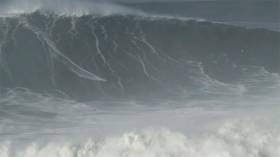Displaying items by tag: Nazaré
The surfing world has paid tribute to Brazilian big wave surfer Marcio Freire after his death at Nazaré last Thursday (5 January).
According to RTÉ News, Freire fell into the water while surfing at the Portuguese swell regarded as producing the world’s largest waves.
Despite rescuers’ attempts to revive him on shore, Freire — known as ‘Mad Dog’ — was pronounced dead at the scene. He was 47.
It marks the first known fatal incident at Nazaré, where Irish-scene regular Andrew ‘Cotty’ Cotton suffered a potentially life-changing spinal injury in November 2017 — though he returned to ride the same waves three years later.
German big wave surfer Sebastian Steudtner holds the current record for the biggest wave ever surfed at 26.2 metres, set at Nazaré in October 2020.
RTÉ News has more on the story HERE.
Surfing Daredevil Andrew ‘Cotty’ Cotton Returns from Broken Back to Take On World’s Largest Waves
Four years after breaking his back when he wiped out surfing the massive swell at Nazaré, a British big wave rider has returned to Portugal conquer his demons, as Metro reports.
Andrew ‘Cotty’ Cotton was a regular at Ireland’s surfing hot spots like Mullaghmore Head before the fateful attempt to ride the infamous wall of water at Praia do Norte in November 2017 that left him with a serious spinal injury.
But the Devon man, now 39, was determined to heal and return to surfing fitness. He was back at Nazaré last year just three years after his potentially life-changing injury.
And this year he’s staying in Portugal for the big wave season, with a view to catching another 80-footer that could mean a place in the record books.
Metro has more on the story HERE.
Mullaghmore Big Wave Regular May Have Set New World Record In Portugal
#Surfing - A regular visitor to Ireland’s big wave surfing hot spots may have broken the world record for the biggest wave ever surfed, as The Irish Times reports.
Cornish surfer Tom Butler rode a giant swell at Nazaré in Portugal last Friday 14 December that was estimated by onlookers to be 30.5 meters high — more than six meters bigger than the previous record.
It follows previous unverified records claimed by German surfer Sebastian Steudtner earlier this year, and Irish-American surf pro Garret McNamara in 2012.
Butler will have to wait till April’s World Surf League Awards to see if he’s set a new bar, but on social media he said he was already “blown away” by the attention.
Previously, an image of Butler in the barrel of a cresting wave at Mullaghmore Head was notated for a Nomad Big Wave Award in 2016, and also made the front page of The Irish Times.
German Surf Pro Rides ‘115 Foot’ Wave Off Portugal
#Surfing - German big wave surfer Sebastian Steudtner has set an unofficial record for the biggest swell ever surfed.
As the Washington Post reports, Steudtner was filmed a fortnight ago surfing a wall of water off Nazaré in Portugal that’s estimated to be 115 feet.
That’s 37 feet bigger than the monster conquered by Irish-American surf pro Garrett McNamara at the same location in November 2011 (though McNamara is said to have surfed an unverified 100ft wave the following year).
“January has been a busy month for big wave surfers in Europe,” said Steudtner, who was towed out to the swell at Praia do Norte along with fellow extreme surfers Axi Munian, Maya Gabeira and Ross Clarke-Jones.
“While Wednesday the first day of the swell was really windy and hard to surf, Thursday was a day to remember.”
'Weather Bomb' Brings Record-Challenging Big Waves, Top Surfers To Nazaré
#Surfing - This is no computer simulation: it's a very real, very large wall of water being surfed by an actual human off Portugal this past Thursday 11 December.
With a poor wind direction putting paid to any attempts to ride big swells crashing in on Ireland's northwest with the recent 'weather bomb', the world's top big wave surfers - including a number of Mullagmore regulars like Andrew Cotton - turned their attentions to Nazaré, site of 2012's record-breaking monster.
And as Magic Seaweed reports, they weren't disappointed, with former Billabong Big Wave Tow-In champion Eric Rebiere calling Thursday's massive rampart "for sure the largest waves I've seen".
Of course, big waves of this exceptional kind are a regular occurrence at this Portuguese hot spot, as this recent photo gallery from the Guardian demonstrates.
Surfers In Ireland, Portugal Prepare For Giant Swells
#Surfing - Surfers across Europe are keeping a close eye on the weather forecast as two large swells are expected to reach the coasts of Ireland and Portugal in the coming days.
SurferToday reports that 100-foot waves could be on the cards for Mullaghmore in Co Sligo, making tomorrow 31 October a happy Halloween for any big wave riders in the region.
Meanwhile, Nazaré in Portugal - site of a reported record-breaking wave earlier this year - is the place to be for the surfing pros from 3-4 November next week.
Scotland and northern Spain will also experience some bigger-than-usual swells as the Atlantic waters rage in our direction.
Surf Record Breaker Garrett McNamara Rides '100ft Wave'
#Surfing - Garrett McNamara has done it again - after riding what is claimed to be the largest wave ever surfed.
Last summer on Afloat.ie we reported that the Irish-American surfing pro had his previous world record attempt - a 78-foot monster off Portugal in November 2011 - confirmed by Guinness record-keepers.
But the Hawaiian wasn't content to rest on his laurels, and on a recent return visit to Nazaré he is said to have smashed his own record with a wave reported to be as much as 100ft in height.
The Guardian has video of McNamara's incredible attempt which you can view below - it's a sight that beggars belief!
McNamara's previous tow-in surf at Nazaré earned him the Biggest Wave title at the 2012 Billabong XXL Big Wave Awards. He shared his $15,000 prize money with Devon surfer Andrew 'Cotty' Cotton, who towed him by personal watercraft into the massive swell.
"Everything was perfect, the weather, the waves," said Northern Irish surfer Al Mennie, who was on hand to witness the pair at Praia do Norte.
Irish Surfer Needs Funds to Attend Big Wave Awards
#SURFING - A young surfer from Lahinch in Co Clare is in the running for the 'biggest wave' prize in the 2012 Billabong XXL contest for his monster ride at Mullaghmore Head, The Irish Times reports.
Ollie O'Flaherty, 24, is nominated along with Devon's Andrew Cotton for the massive surf they caught off Co Sligo on 8 March last.
It was the first visit to the world-class big wave spot by O'Flaherty, a science student at NUI Galway who is a veteran of the Co Clare scene.
As previously reported on Afloat.ie, it was Cotton who tackled the biggest wave on that day - a giant 50-footer - as some of the world's top surfers took advantage of the Viking swell.
Also nominated for the $50,000 (€38,280) prize is Irish-American surfer Garrett McNamara, who last year rode what is being called the biggest wave ever surfed in the world, a 90-foot goliath off Nazaré in Portugal.
According to the Irish Independent, O'Flaherty has put out a call for sponsorship so he can attend the awards ceremony next month.
"It's a massive honor to be able to represent Ireland," he said, but added that he is "pretty much on the breadline from what I'm doing".
Should he win, the Lahinch native said he intends to "put every cent back into surfing" and replace his seven broken boards.
The winners will be announced at the Billabong XXL Big Wave Awards in Anaheim, California on 4 May.
Irish-American Surfs 'World's Biggest Wave'
#SURFING - An Irish-American has ridden what's being called the biggest wave ever surfed in the world.
Garrett McNamara from Hawaii caught the 90-foot monster wave off the coast of Nazaré in Portugal earlier this month, The Irish Times reports.
"Everything was perfect, the weather, the waves," said Northern Irish surfer Al Mennie, who was tow-in surfing with McNamara and English rider Andrew Cotton when the giant swell arose at Praia do Norte.
The offshore area is noted for its deepwater canyon that channels massive swells from the Atlantic.
“As I rode this wave, it seemed pretty massive, but I couldn’t tell quite how big it was,” McNamara told surf forecast site Surfline.
“When I got to the bottom and turned and got around the wave and went to kick out, it landed on me and it felt like a ton of bricks.
"Probably one of the most powerful waves ever to land on me at the shoulder," he added. "It was pretty amazing.”
McNamara - whose family has Irish roots, according to Irish Central - is working with the Portuguese Hydrographic Institute as part of the ZON North Canyon Project, which aims to learn how waves reach such significant heights at Praia do Norte.
See video of the record-shattering wave ride below:



































































